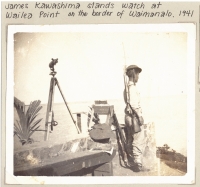At 7:55 a.m. on December 7, 1941, the usual calm of a Sunday morning in Honolulu was shattered by the sound of explosions. The airplanes, easily recognizable as belonging to the empire of Japan by the bright red circle painted on their sides, launched an all-out attack on the naval base at Pearl Harbor and military airfields on Oahu.
Available military personnel rushed to their respective stations, but anything could be done to counter the ferocity of the surprise attack which resulted in the devastating loss of aircraft and battleships, as well as both military and civilian lives.
Within hours of the attack, martial law was declared, placing the Territory of Hawaii under military control. Agents of the Federal Bureau of Investigation, military personnel and police arrested individuals whom they considered dangerous enemy aliens, including Japanese religious leaders, language school teachers and principals, martial arts instructors, community leaders, Japanese newspaper reporters, Kibei (American-born Japanese who had spent their formative years in Japan or had been educated there), and German and Italian nationals. Those who remained in their homes were routinely intimidated with searches, during which time heirlooms, pictures and items bearing perceived connections to Japan were seized and destroyed.
On December 8, 1941, a day after the attack, the United States declared war on Japan, and three days later, on Germany and Italy.
In the days and weeks following the attack on Pearl Harbor, the Japanese community lived in constant fear of what would happen to them. Many had already seen husbands and fathers picked up by authorities, with little or no information provided as to where they were being taken or when they would return home, if ever.
On February 19, 1942, President Franklin Roosevelt signed Executive Order 9066, paving the way for the mass internment of 110,000 West Coast Japanese in camps as far east as Arkansas. Hawaii, with a population of close to 160,000 Japanese, was spared mass incarceration. According to historian and Columbia University professor Dr. Gary Okihiro, between 1942 and 1945, 1,875 Hawaii Japanese were transferred to camps on the continental U.S. Another 1,466 were held in camps in the Islands.
There was considerable discussion among military and political leaders about whether Hawaii’s large Japanese population posed a security risk and should be interned. In the end, however, it was deemed logistically and economically impractical to intern such a large percentage of the Islands’ workforce, many of whom held vital skilled labor positions. And, despite reports of sabotage and espionage, military authorities found no evidence that these activities were being perpetrated by people of Japanese ancestry in Hawaii.
During the attack on Pearl Harbor, the 1st Battalion of the 298th had been stationed at Schofield Barracks, while the 2nd Battalion had been protecting the shoreline of Windward Oahu. For the next six months, through most of summer, soldiers in the 298th Infantry continued to patrol the shorelines of Oahu, string barbed wire and man machine gun emplacements. On the neighbor islands, the 299th soldiers did similar work and also helped build military installations.
About two hours after the attack began, Governor Joseph Poindexter created the Hawaii Territorial Guard (HTG) to serve as the defense force for the territory under his authority since the Hawaii National Guard units had been federalized and transferred to U.S. Army command. Included in the HTG was the University of Hawaii Reserve Officers’ Training Corps (ROTC), which was sent to guard key installations. Each HTG member was issued an old Springfield rifle and a single clip of five shells and ordered to guard generators, power stations and other crucial infrastructure.
On January 19, 1942, however, 317 Nisei members of the Hawaii Territorial Guard were relieved of their duties without explanation. Surprised, angry and disappointed, the men were determined to find another way to serve their country. A month later, they sent a petition to the military governor, Lieutenant General Delos Emmons, offering themselves “for whatever service you may see fit to use us.” They were given permission to form a volunteer labor battalion which became known as the Varsity Victory Volunteers.

![Barbed wire covers a Hawaiian beach after the bombing of Pearl Harbor, 1942 [Courtesy of Ruth Oian Pratt, Bishop Museum] Barbed wire covers a Hawaiian beach after the bombing of Pearl Harbor, 1942 [Courtesy of Ruth Oian Pratt, Bishop Museum]](https://stage.100thbattalion.org/wp-content/gallery/battalion-history-war-is-declared/cache/chang_thelma_011.jpg-nggid03394-ngg0dyn-200x0x100-00f0w010c011r110f110r010t010.jpg)
![Pearl Harbor Disaster [Honolulu Star-Bulletin] Pearl Harbor Disaster [Honolulu Star-Bulletin]](https://stage.100thbattalion.org/wp-content/gallery/battalion-history-war-is-declared/cache/just-americans_01.jpg-nggid03395-ngg0dyn-200x0x100-00f0w010c011r110f110r010t010.jpg)

![Soldiers of the Hawaiian Provisional Battalion march in Honolulu, 1942 [Courtesy of 100th Clubhouse] Soldiers of the Hawaiian Provisional Battalion march in Honolulu, 1942 [Courtesy of 100th Clubhouse]](https://stage.100thbattalion.org/wp-content/gallery/battalion-history-war-is-declared/cache/scan-110519-0010.jpg-nggid03398-ngg0dyn-200x0x100-00f0w010c011r110f110r010t010.jpg)